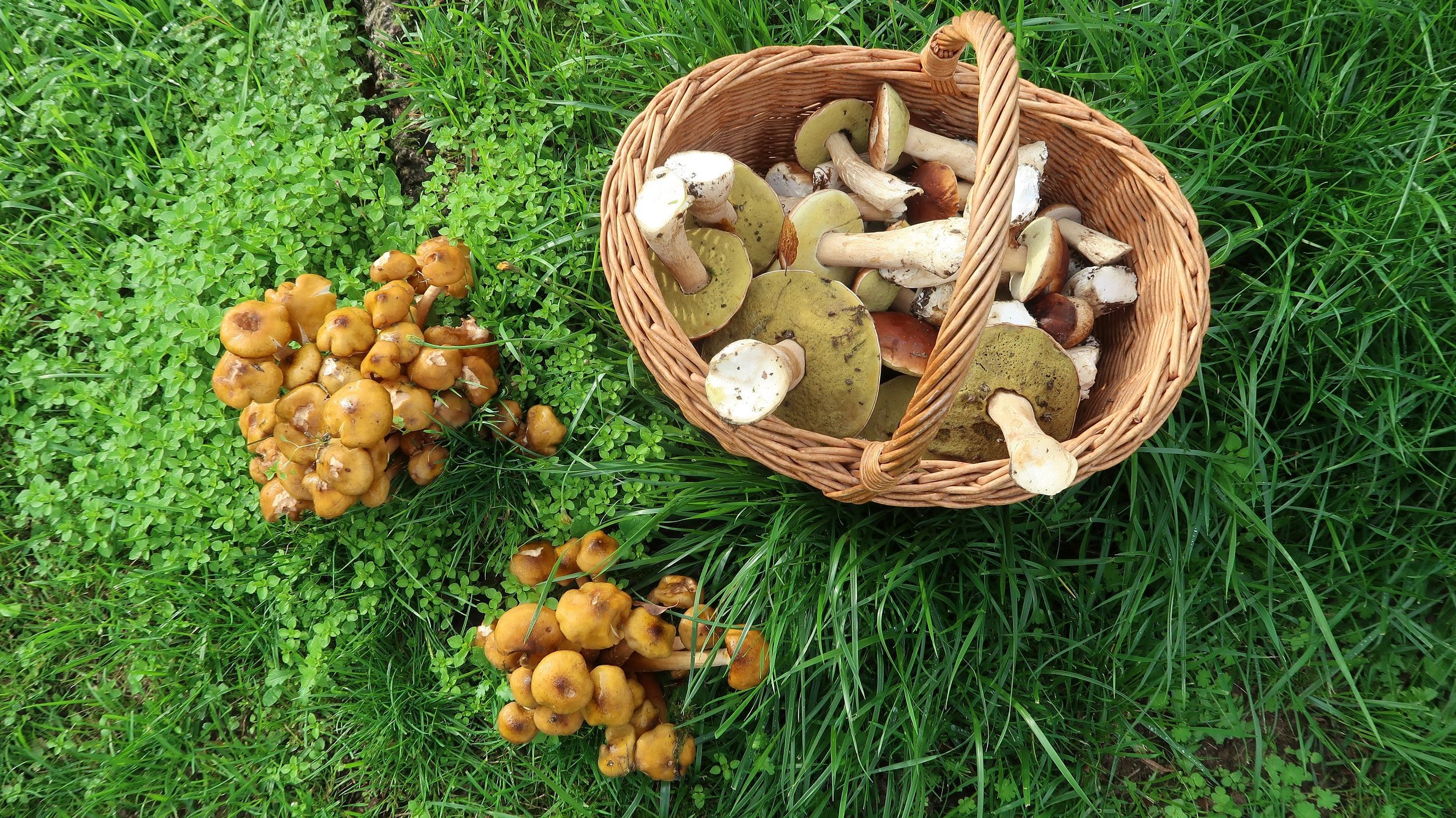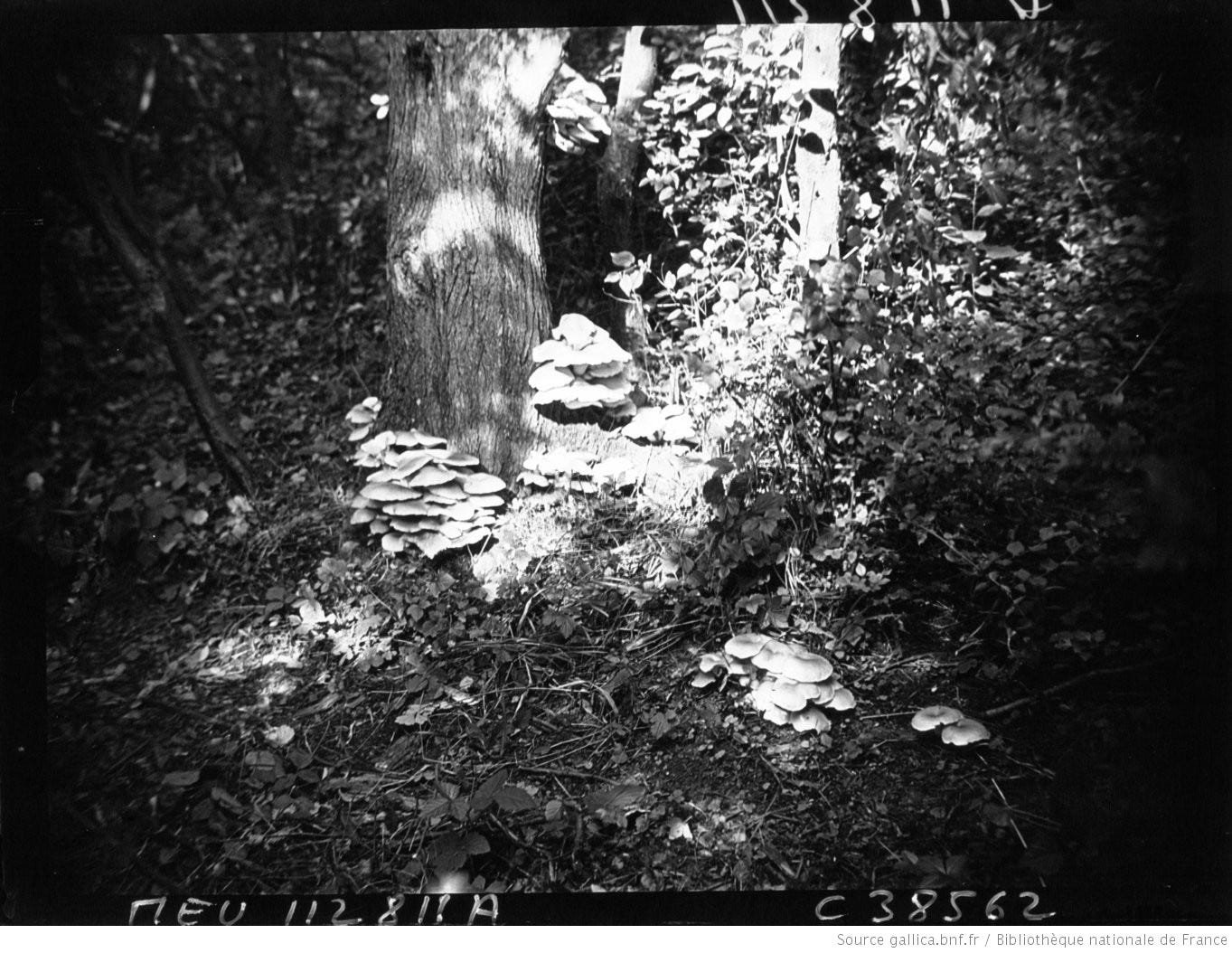Gathering wild mushrooms
Autumn days shorten and the "champignon" springs up
Above: Our delectable harvest of ceps. The "cèpe" is known as "le roi de la forêt," the king of the forest.
Chère amie, cher ami,
The autumn sun sends slanted rays of amber light across the Great Lawn. Velvety shadows fall across the grass. A drift of sodden leaves stirs suddenly in a gust of breeze. And a mild chill descends with the setting sun.
Afternoon comes early these days.
We are walking along the lisièreIT of the woods, searching for mushrooms. No native-born Française, I pick them after prudent examination. As Pliny the Elder so wisely wrote circa 70 A.D.:
“Among the things which it is rash to eat, I would include mushrooms, as although they make choice eating they have been brought into disrepute by a glaring instance of murder."
The murder was that of the Emperor Claudius by his evil wife Agrippina, mother of Nero. She served him a dish of poisoned mushrooms.
But luckily, we are accompanied by a friend, wise in la cueillette, the gathering of wild mushrooms. Pierre knows the secret spots where the roi de la forêt, the cèpe is found, as well as other seasonal apparitions like the rosé de prés.
…
Je franchirais forêts et steppes
Pour savourer un plat de cèpes…
Vivent les cèpes ! Ma narine
Croit les sentir dans la bassine
Pleine d’huile et d’ail haché fin.
O saveurs ! ô douceurs ! ô joies !...”
I would cross forests and the steppe
To taste a plate of cep…
Long live the cep! My nostril
Believes it sniffs them in the pan
Fried in oil and in garlic fine.
O taste! O sweetness! O joy!
My son Henry and I first gathered mushrooms in the French woods with François, the old vacher who took care of the cattle at the Chateau. Henry was a young fellow of six. We traipsed along after François, poking into the undergrowth, delighted when we came upon clumps of mushrooms and stands of bolets.
“Ah, non, petit!” François might gently remonstrate. We had showed him a red-capped specimen spotted with creamy warts, the kind that elves live under.
“Ça fait très mal!”
Not all the dangerous mushrooms were as showy. Some looked alarmingly like the delicious varieties.
Patiently, François showed us the distinctive gills, caps, and stems of the various champignons. He wanted us to notice the particular places where the edible mushrooms grew, and where they reliably returned every year. Thinking back, I suppose he was sharing his private and precious knowledge with us, and probably particularly with Henry, just as once my grandfather had shown me the places where he always caught trout.
Mycena inclinata, or quélet, by Claude Aubriet. Not poisonous, but not worth eating, say François and Pierre. Aubriet's illustrations of mushrooms were made for botanical texts in the 18th century.
At the time, I mostly wanted to know how to recognize a champignon vénéneux. But François, who retired a few years later, perhaps wanted to be sure his lifetime’s treasured-up savoir-faire would be preserved. He was passing it on to the new châtelains. A few years later, he retired.
“The taste for mushrooms undoubtedly evolved along Darwinian lines,” remarked our friend Raynald, interrupting my reverie. Professor at the Sorbonne, he turns his erudite attention to country pursuits on the weekends.
“The taste for the mushroom is very ancient. As we know from Pliny, the Romans ate mushrooms. And the ancient Greeks grew them, almost as we do today, in troughs of manure.”
“Of course, the Chinese grew them, too,” Henry remarked, lifting his head from his study of the woodland floor. “At least as far back as 600 A.D.”
“Ah, bon?” stated Raynald, politely.
The French have great admiration for the Chinese, with their estimable discovery of silk, porcelain, automatons, fireworks, and their elaborate rituals around the dining table. But the division of the world into Occident and Orient is not only a convenient if arbitrary geographical division. It reflects a deep historical and intellectual sense of identity. “The Way of Tao” or the writings of Confucius were not among “les textes fondateurs” that our children studied in French schools. The founding texts of la civilisation begin with Platon and Pline.
Theophrastus, a student of Plato and the author of “An Inquiry concerning plants” had alluded to mushroom cultivation in Ancient Greece in the 4th century B.C., Raynald reminded Henry.
Unfortunately, in France, the fall of the Roman Empire and the Barbarian invasions catastrophically disrupted culinary and agrarian traditions. A thousand years passed before the mushroom was once again cultivated on French soil.
The French 17th century, Raynald went on, his voice quickening with enthusiasm, was a period of tremendous change and growth. And thus the humble mushroom sprouted again in le potager.
Successive kings and successive wars with the Italians and the Spanish, the Normans and the Burgundians had beaten back rival dynasties. France’s southern, northern and eastern borders were established. The power of overweening nobles within France was crushed. And France’s periodic and devastating civil wars and peasant revolts had ended by the mid-17th century.
“Au moins,” added Raynalt with a weary shrug, “until the Revolution.”
Pierre, intent on the ground, stopped suddenly and bent over a rotting log. Around it, dissimulated amid the brown and yellow leaves, were the sloping, velvety, deep-brown caps of the cep.
But Raynald had warmed to his theme.
France, always rich in wheat and cattle, now had the wealth and leisure to cultivate the arts as well. And its young and dynamic king – Louis XIV, the Sun King, who assumed power in 1661 – made the French court into the summum of splendor and fashion. Music, dancing, theatre, sculpture and the decorative arts flourished at Versailles and in Paris, at other chateaux and in other towns. The arts of gardening did, too.
Vast sums were spent on gardens. At Versailles, the king’s head garden designer and gardener Jean-Baptiste de la Quintinie founded “le potager du roy.”
And he planted mushrooms.
These were the wild rosé de prés, the Agaricus campestris that sprouts up in our fields and pastures in cool and rainy conditions. The roséIT looks very much like the modern cultivated mushroom, the button-shaped Agaricus bisporus, commonly called the ITchampignon de Paris. In about 1670, the royal gardener developed a method for growing it in trenches filled with horse manure, just as had the Greeks.
We wondered if mushrooms had been cultivated in the potager of the old Chateau in the 1670s.
"Boff” muttered Pierre. He had been assiduously plucking up the ceps and handing them to me to put in the basket. Now, he turned one of the ceps around in his calloused hands. Though magnificent, meaty and broad, the cep had been partially devoured by an insect. He discarded it.
“Scholars agree,” continued Raynald, “that the development of gardening was linked to a dramatic change in gastronomy – to the invention of la cuisine française, French cuisine.
“The humble meadow mushroom plays an honorable rôle in that improvement as well.”
The afternoon light was fast waning.
Henry and I looked at Raynald expectantly, conscious that our feet were growing cold. Pierre, having culled the plantation of ceps and harvested those whose flesh was firm and mostly intact, had straightened up.
Foraging in the forest, a photograph from 1934.
“The very first cookbook of the 17th century in France was also the first livre de cuisine written in about 300 years,” Raynald instructed us, rather hastily. “Up until then, a cook might rely on a reprint of a medieval cookbook. Then, in 1650, Pierre François de La Varenne, chef for the Duc d’Uxelles, wrote “Le Cuisinier français.”
Instead of heavy spices from the East, La Varenne stressed garden herbs like parsley and thyme. He used a wide variety of fresh vegetables. Mushrooms figured in the menu, too.
“This same author invents "le duxelles",” concluded Raynald. “A paste made with mushrooms, butter and shallots. It is still an élément fondateur of la cuisine française. So, you see, it was impératif that the potager must produce mushrooms for these new dishes.”
No-one disputed Raynald’s assertion. We were eager to get back to a fire and the prospect of an omelet stuffed with buttery slices of sautéed cep.
Pierre looked down at our basket, brimming with the rich brown caps and pale dun-hued stems of the boletus.
“No one, not even the most erudite French agronome, has discovered how to grow le cèpe in a garden,” he said.
“We must rely on finding them in the woods.”
And with that, he led us over the low brambles and long grasses that tugged at our boots, back towards the Chateau.
Wishing you a very happy Thanksgiving!
Elisabeth
Your correspondent preparing the harvest...to be sliced, sautéed lengthily in butter, and then frozen for winter eating.
P.S. The recipe below for preparing wild mushrooms is from the "Mesnagier de Paris," the medieval book of household advice written in 1393 for a young wife.
The manuscript reads "Young mushrooms of a night are the best, and small and with caps of gilded bronze, and one must peel them, wash them in hot water and parboil them; if you wish to bake them in a pie, so put in oil, cheese, some flour, and a pinch of salt. Put the pastry between two plates upon hot coals."
P.P.S. About 20 minutes drive from Courtomer is the forêt d’Ecouves, where gathering mushrooms is permitted from 8 heures to sunset every day other than Tuesday and Thursdays, and not while a deer or boat hunt is taking place. Only 5 liters of mushrooms may be gathered by one person in a day, a quantity a little larger than a gallon jug.
As always, Heather and Beatrice (info@chateaudecourtomer.com and +33 (0) 6 49 12 87 98) will be happy to help you reserve your own holiday or special gathering at the Chateau or just to rent the Chateau, the Farmhouse or both. We have just a few openings for the end of this year and in 2023, and are taking bookings for 2024 and 2025. We look forward to hearing from you. A bientôt!





